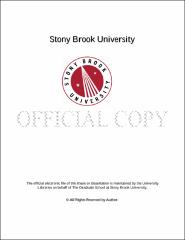| dc.identifier.uri | http://hdl.handle.net/11401/78368 | |
| dc.description.sponsorship | This work is sponsored by the Stony Brook University Graduate School in compliance with the requirements for completion of degree | en_US |
| dc.format | Monograph | |
| dc.format.medium | Electronic Resource | en_US |
| dc.format.mimetype | Application/PDF | en_US |
| dc.language.iso | en_US | |
| dc.type | Dissertation | |
| dcterms.abstract | Multicilia are microtubule-based cellular projections that provide the motive force to propel mucus and debris out of our airways, cerebrospinal fluid in our nervous system, and the ovum in the female reproductive tract. Dysfunctional multicilia have been linked to genetic disorders, such as primary ciliary dyskinesia and cystic fibrosis, and been implicated in the pathologenesis of chronic respiratory diseases, including emphysema, chronic obstructive pulmonary disorder, and asthma. While multicilia play an absolutely essential role in human health, very little is known about how multicilia form and function. However, work from primary cilia, which are responsible for cellular signaling, as well as mutation analysis from human patients, has shown that a structure at the base of cilia termed the transition fiber (or distal appendage) is important. Therefore, to gain greater insight into the function of the transition fiber, I utilized two unique mouse knockout models where expression of the two transition fiber proteins Chibby1 and CEP164 was lost. I employed various imaging modalities, including super-resolution and electron microscopy, tissue histology, and primary cell culture techniques to interrogate the function of Chibby1 and CEP164 in different stages of multicilia formation. Interestingly, I report that Chibby1 regulates intraflagellar transport, a process responsible for building and maintaining ciliary axonemes. Additionally, my work has determined that CEP164 is necessary for mammalian development and multiciliogenesis through the generation and characterization of a novel mouse model. I extend the role of CEP164 in basal body docking and ciliary vesicle formation to multicilia formation; however, I also reveal intriguing differences in CEP164 function in primary and multiciliogenesis. In particular, CEP164 limits the types of cellular membranes and associated membrane proteins that compose multicilia. These findings provide increased understanding into the physiological functions of the transition fiber and shed light on how proteins localizing to this critical structure function to build multicilia. | |
| dcterms.available | 2018-07-09T14:29:27Z | |
| dcterms.contributor | Frohman, Michael A. | en_US |
| dcterms.contributor | Takemaru, Ken-Ichi | en_US |
| dcterms.contributor | Colognato, Holly. | en_US |
| dcterms.contributor | Chen, Jiang. | en_US |
| dcterms.creator | Siller, Saul Sylvan | |
| dcterms.dateAccepted | 2018-07-09T14:29:27Z | |
| dcterms.dateSubmitted | 2018-07-09T14:29:27Z | |
| dcterms.description | Department of Molecular and Cellular Pharmacology. | en_US |
| dcterms.extent | 149 pg. | en_US |
| dcterms.format | Monograph | |
| dcterms.identifier | http://hdl.handle.net/11401/78368 | |
| dcterms.identifier | Siller_grad.sunysb_0771E_13312.pdf | en_US |
| dcterms.issued | 2017-08-01 | |
| dcterms.language | en_US | |
| dcterms.provenance | Submitted by Jason Torre (fjason.torre@stonybrook.edu) on 2018-07-09T14:29:27Z
No. of bitstreams: 1
Siller_grad.sunysb_0771E_13312.pdf: 5581406 bytes, checksum: b767133b0419421f0cb8be6c1f53ce8f (MD5) | en |
| dcterms.provenance | Made available in DSpace on 2018-07-09T14:29:27Z (GMT). No. of bitstreams: 1
Siller_grad.sunysb_0771E_13312.pdf: 5581406 bytes, checksum: b767133b0419421f0cb8be6c1f53ce8f (MD5)
Previous issue date: 2017-08-01 | en |
| dcterms.subject | CEP164 | |
| dcterms.subject | Cytology | |
| dcterms.subject | Developmental biology | |
| dcterms.subject | Chibby1 | |
| dcterms.subject | Cilia | |
| dcterms.subject | Multiciliated cells | |
| dcterms.subject | Transition fiber | |
| dcterms.subject | Vesicle trafficking | |
| dcterms.title | The Centriolar Distal Appendage Proteins CEP164 and Chibby1 Coordinate Multiple Steps in the Formation and Maintenance of Airway Multicilia | |
| dcterms.type | Dissertation | |

